
Deoksugung (Korean: 덕수궁) also known as Gyeongun-gung, Deoksugung Palace, or Deoksu Palace, is a walled compound of palaces in Seoul that was inhabited by members of Korea's royal family during the Joseon monarchy until the annexation of Korea by Japan in 1910. It is one of the "Five Grand Palaces" built by the kings of the Joseon dynasty and designated as a Historic Site. The buildings are of varying styles, including some of natural cryptomeria wood), painted wood, and stucco. Some buildings were built of stone to replicate western palatial structures.
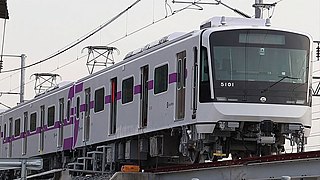
Seoul Subway Line 5 of the Seoul Metropolitan Subway, dubbed the purple line, is a long line crossing from west to the east across the Seoul National Capital Area, South Korea. It is one of two subway lines in Seoul to cross under the Han River, which is done at two points. The main line runs through to Hanam Geomdansan Station while the branch line from Gangdong Station terminates at Macheon Station. In 2019, Line 5 carried an annual ridership of 334 million or about 915,000 passengers per day.

Gyeonghuigung is a palace located in Seoul, South Korea. It was one of the "Five Grand Palaces" built by the Joseon Dynasty.
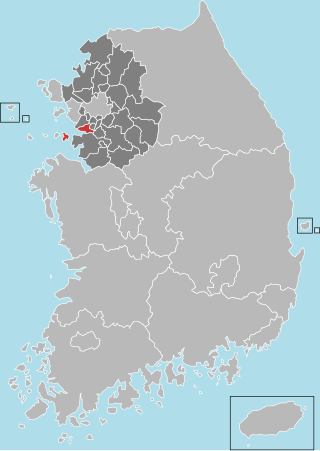
Ansan is a city in Gyeonggi Province, South Korea. It lies southwest of Seoul and is part of the Seoul National Capital Area. It is connected to Seoul by rail via Seoul Subway Line 4. It is situated on the Yellow Sea coast and some islands lie within its jurisdiction. The largest and best-known of these is Daebu Island.

Seoul Subway Line 6 is a line of the Seoul Metropolitan Subway. The route connects Eunpyeong-gu and Jungnang-gu in a U-shaped manner, running through Yongsan-gu and Seongbuk-gu. It does not cross the Han River. It is mainly used to connect to the northern outskirts of Seoul and to relieve the traffic on other lines.

Sejongno (Korean: 세종로), officially Sejong-daero (Korean: 세종대로) is a street that runs through Jongno-gu in downtown Seoul. It is named after King Sejong the Great of Joseon. The street is 600 meters in length, but due to its central location it is of great symbolic importance. It points north to Gwanaksan and Bukhansan (Mountains), and the Joseon Dynasty palace, Gyeongbokgung. It is also of historical significance as the location for royal administrative buildings and features statues of the Admiral Yi Sun-sin of Joseon Dynasty and King Sejong the Great of Joseon.

Yeongdeungpo District is an administrative district in southwest Seoul, South Korea. Although the origin of the name is uncertain, the first two syllables are thought to be from "yeongdeung" (靈登) or "divine ascent", a shamanic rite. The third syllable is "po", representing the bank of a river (浦), referring to the district's position on the Han River. The 2006 population was 408,819.

Seocho District is one of the 25 local government districts which make up the city of Seoul, South Korea. Seocho is a part of the Gangnam region, along with the Gangnam district of Seoul. Seocho District ranks as one of the richest neighborhoods in South Korea and among the most expensive areas in Seoul with an average sales price of 47.75 million South Korean won per 3.3 square meters. Many of the wealthiest residents are concentrated in the three Gangnam districts including Seocho, known as Gangnam School District Eight.
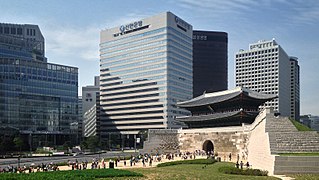
Jung District is one of the 25 districts of Seoul, South Korea.

Gwanghwamun is the main and largest gate of Gyeongbok Palace, in Jongno-gu, Seoul, South Korea. It is located at a three-way intersection at the northern end of Sejongno. As a landmark and symbol of Seoul's long history as the capital city during the Joseon period, the gate has gone through multiple periods of destruction and disrepair. The most recent large-scale restoration work on the gate was finished and it was opened to the public on August 15, 2010.

Express Bus Terminal Station is a station on Seoul Subway Line 3, Line 7, and Line 9. The stations are located in the Greater Gangnam Area, Banpo-dong, Seocho District, Seoul, Korea.

Dongdaemun station is a station on Line 1 and Line 4 of the Seoul Metropolitan Subway. Sometimes called Dong Station, it is named after one of the Four Great Gates of the circular wall surrounding ancient Seoul, and is situated on the eastern end of Jongno. This station is also close to Dongdaemun Market.

Sosa Station is a station on Seoul Subway Line 1 and Seohae Line in Bucheon City, west of Seoul.

Seoul City Hall is a governmental building for the Seoul Metropolitan Government in South Korea, in charge of the administrative affairs of Seoul. It is located in Taepyeongno, Jung-gu, at the heart of Seoul. It is connected to City Hall Station (Seoul) on Seoul Subway Line 1, with access to Seoul Subway Line 2 from the same station. In front of the current city hall is the old city hall building, now Seoul Metropolitan Library, and Seoul Plaza.

Ilmin Museum of Art is a private art museum of South Korea, located on Sejongno street in Jongno-gu, a central district of Seoul, known for exhibiting mainly Korean art. The museum was established and run by the Ilmin Cultural Foundation (Korean: 일민문화재단), a non-profit organization founded in 1994 in memory of Kim Sang-man, former president of Dong-A Ilbo, one of the major newspaper companies of South Korea. Kim devoted his entire life to developing Korean journalism and promoting Korean culture. The museum is named after his pen name, "Ilmin".

The National Palace Museum of Korea (Korean: 국립고궁박물관) is a national museum of South Korea located in Gyeongbokgung Palace, Seoul.

The Seoul Museum of Art (Korean: 서울시립미술관) is an art museum operated by Seoul City Council and located in central of Seoul, South Korea.
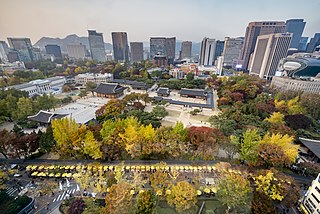
Seoul, officially Seoul Special City, is the capital and largest city of South Korea. The broader Seoul Capital Area, encompassing Gyeonggi province and Incheon Metropolitan City, emerged as the world's sixth largest metropolitan economy in 2022, trailing behind Paris, San Francisco, Los Angeles, Tokyo, and New York, and hosts more than half of South Korea's population. Although Seoul's population peaked at slightly over 10 million, it has gradually decreased since 2014, standing at approximately 9.97 million residents as of 2020. Seoul is the seat of the South Korean government.
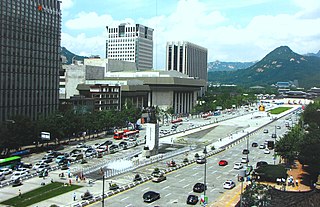
Gwanghwamun Square is a public square on Sejongno, Jongno-gu, Seoul, South Korea. Serving as a public space and at times road for centuries of Korean history, it is also historically significant as the location of royal administrative buildings, known as Yukjo-geori or Street of Six Ministries; and features statues of Admiral Yi Sun-sin of Joseon Dynasty and King Sejong the Great of Joseon.
The following is a timeline of the history of the city of Seoul, South Korea.





















